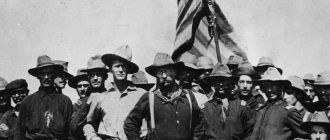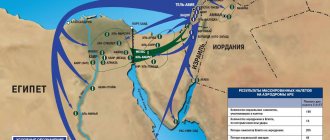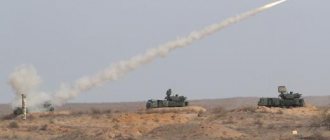The formation of the Israeli state in 1948 led to numerous conflicts in the Middle East. Combat operations against Israel began immediately with the emergence of this country; its main opponents were Syria and Egypt.
Subsequent history did not contribute to the stabilization of the region. Israel has constantly had border conflicts with Syria, leading to large-scale military operations. A similar situation was observed with Egypt.
The Suez crisis of 1956 again ended in the Egyptian-Israeli war, which resulted in the appearance of UN peacekeepers on the border between the two states. Their presence helped reduce the number of border incidents, but failed to ensure peace in the region. The Six Day War of June 5-10, 1967 confirmed its instability.
Six Day War [↑]
The third war between Israel and the Arab countries, which lasted from June 5 to 10, 1967. Within six days, the young Jewish state inflicted a crushing defeat on the united army of five Arab countries: Egypt, Jordan, Syria, Iraq and Algeria. The outcome of the war was predetermined by a surprise attack by the Israeli Air Force on Egyptian, Jordanian and Syrian military airfields, as a result of which the majority of enemy air forces were destroyed and, thus, Israel achieved undeniable superiority in airspace.
Israel celebrates victory
The latest stage of fighting took place along Israel's northeastern border with Syria. On June 9, after intense aerial bombardment, Israeli tanks and infantry advanced deep into Syria into the Golan Heights. The next day the Golan was captured.
On June 10, 1967, the UN ceasefire agreement came into force, ending the Six Day War. It was later determined that approximately 20,000 Arabs and 800 Israelis had died in just 132 hours of fighting.
The leaders of the Arab states were shocked by the losses suffered. Egyptian President Nasser was forced to return to his residence in disgrace when mass demonstrations against him began among the people.
Israel rejoiced. In less than a week, the young state was able to capture the Sinai Peninsula, Gaza Strip and Golan, defeating superior enemy forces and suffering relatively few losses.
Prerequisites for war [↑]
After the 1948 War of Independence, despite an armistice agreement, Arab countries refused to recognize the right of the State of Israel to exist and the right of Jews to live on this land. For 19 years, Arab extremists have been active in terrorist activities against Israel. Sabotage has especially increased since 1960, when extremist nationalist sentiments intensified in Arab countries under the influence of Nasser’s propaganda.
In addition to this, in 1964, when the construction of the all-Israel water pipeline was being completed, Syria invited the Arab countries to start a war against Israel in order to prevent the completion of this project. At a meeting of leaders of Arab countries (Casablanca, January 1964), it was decided to block the tributaries of the Jordan River at their sources in Syria. Israel said that this would lead to a sharp decrease in the water level of Lake Kinneret and that it would consider the implementation of this plan as a casus belli.
On May 21 and 22, 1967, Egyptian President Nasser ordered the closure of the Strait of Tiran, Israel's only sea access to the Indian Ocean. Israel said that the blockade of the Strait of Tiran is regarded as a provocation to military action.
Escalation
Nasser continued to pursue an aggressive policy. On May 22, he banned Israeli ships from crossing the Strait of Tiran, which connects the Red Sea and the Gulf of Aqaba. A week later, he signed a military alliance treaty with King Hussein of Jordan.
The situation in the Middle East became increasingly tense, and American President Lyndon Johnson entered into negotiations with both warring parties. He warned them against starting hostilities and tried to gain support from the International Maritime Organization to reopen the Strait of Tiran. However, this plan was not destined to come true. By early June 1967, Israeli leaders voted to counter the Arab military buildup on Israel's borders. A decision was made to launch a pre-emptive strike on the Egyptian Air Force.
On the eve of the war [↑]
Throughout the pre-war period, massive propaganda was carried out among the population of Arab countries calling for the destruction of the Jewish state and the murder of Jews. The campaign was accompanied by characteristic cartoons and speeches by politicians. Egyptian President Nasser repeatedly repeated his intention to “throw the Jews into the sea”, destroying them as a nation, and PLO Chairman Shuqeyri stated that in the event of an Arab victory, “the surviving Jews will be helped to return to the countries of their birth.” “But it seems to me that no one will survive,” he added.
On November 4, 1966, Syria and Egypt entered into a military alliance. Syria has intensified shelling of the northern part of the country. On April 7, 1967, Israeli aircraft shot down six enemy military aircraft in Syrian airspace.
At the beginning of May 1967, Soviet representatives conveyed deliberately false information to Nasser about the concentration of Israeli troops on the Syrian-Israeli border. Despite the response from UN observers stationed along the border between Israel and Syria that there were no “major movements of military units on either side of the armistice line,” Nasser decided to act. On May 16, large military contingents passed through Cairo, heading towards the Sinai. 16 May Egypt demands the UN withdraw UN security troops patrolling the 1948-1956 ceasefire line. On May 18, following the hasty withdrawal of UN forces, Cairo's Voice of the Arabs radio announced: “As of today, there is no longer an international emergency force defending Israel. We will no longer show restraint. We will no longer appeal to the UN with complaints against Israel. The only method of influence that we will use against Israel will be a total war, the result of which will be the destruction of the Zionist state.”
On May 30, a pact was signed between Egypt and Jordan, which placed the Jordanian army under the command of Egyptian generals. On May 31, an agreement was concluded between Jordan and Iraq. In addition to this, other Arab countries, such as Algeria, Saudi Arabia, Kuwait, have declared their readiness to provide military contingents for the war with Israel.
Israel was confronted by a powerful coalition of countries with significant military superiority both in the number of soldiers and weapons, and in the quality of military equipment. Regular military assistance from the USSR to Egypt, new equipment and modern weapons posed a real threat to the existence of Israel. The number of dead and wounded was expected to be enormous. 14,000 beds have been prepared in hospitals across the country. 1000 graves were dug.
Background and reasons
Israeli military
The creation of the Israeli state after World War II turned out to be partly artificial. Palestine was to be divided into Jewish and Arab states, with international control over Jerusalem and Bethlehem. However, this situation did not suit the Arabs - in a given territory, only a third of the population was Jewish.
Despite this, on May 14, 1948, David Ben-Gurion declared the independence of Israel. The Union of Arab States immediately declared war on him, but within a year it not only failed to achieve success, but also allowed the Israeli army to occupy a number of new territories.
During this conflict, there was a massive exchange of refugees. About 600 thousand Arabs were evicted from Israeli territories. At the end of the war, the Israeli government refused to let them back, confiscating all land and property. In response to this, pogroms of Jewish communities took place in Arab countries, as a result of which about 820 thousand Jews arrived in Israel.
This situation has not improved the situation in the region. Both sides saw each other as a threat; any border incident or provocation escalated into conflict. Punitive measures were taken on both sides.
By 1967, relations with Egypt had improved in part due to the actions of UN peacekeepers. The main conflict was brewing with Syria. There are three reasons for controversy in this event:
- water problem - Syria has begun work to change the course of the Jordan River, which feeds Lake Kinaret and significantly affects Israel's agriculture and economy;
- disputed control of the demilitarized zone along the ceasefire line established in 1948;
- Syrian support for Palestinian troops committing sabotage in Israel.
An alliance was signed between Syria and Egypt in November 1966. However, in Israel they believed that the latter was not ready for war. According to intelligence reports, 8 elite Egyptian brigades participated in the civil war in Yemen on the side of the Republicans.
The situation between Israel and Syria worsened, and border clashes increasingly turned into armed confrontation. On May 13, 1967, the USSR sent an official notification to Egypt about the concentration of 11-13 Israeli brigades on the border with Syria. The expected date of the attack was May 17.
Having received the notification, Egypt begins to mobilize troops. On May 16, he appeals to the UN with a request to withdraw peacekeepers from the border areas. On the same day, Israel began mobilization; on May 17, Jordan began preparing for war.
On May 23, Saudi Arabia announces its readiness to join the war. Sudan mobilizes on May 28. The next day, troops from Algeria arrive in Egypt. On May 31, Iraqi troops move to Jordan. Among the Arab states, calls to “throw the Zionists into the sea” began to be heard again. In this situation, Israel had to fight against almost all the states surrounding it.
Brief chronicle of the war [↑]
- First day of the war
,
June 5, 1967, Monday
. The Israeli leadership decides to take military action first, launching a surprise attack on air bases in Sinai. At 7:45 am, in a surprise airstrike, the Israeli Air Force destroys 11 Egyptian air bases, including runways, aircraft and military equipment. Despite the obvious defeat of the Egyptian air force, Egypt, continuing its propaganda, reports an absolute lie, claiming that the air raid was repulsed and Israel suffered irreparable losses. At 8:30, having learned about the start of the war and about the "losses" of the Israelis, the Jordanians open fire along the border line in Jerusalem. At 1 p.m., Jordanian soldiers occupy the UN headquarters in Jerusalem. In response, the Israeli Air Force destroys Jordanian air bases. After this, Syrian air bases are bombed. At this stage of the war, with G-d's help, Israel gains absolute superiority in airspace. In parallel, three Israeli divisions under the command of Generals I. Tal, A. Joffe and A. Sharon are advancing deep into the Sinai Peninsula, striking enemy ground targets. - Second day of the war, June 6, Tuesday
. On the Southern Front, Israeli soldiers continue to advance across the Sinai Peninsula in two directions: northwest, towards the Suez Canal, and south, towards the Jabal Libni area. Another infantry brigade, reinforced with tank units and paratroopers, occupies Gaza by midday. On the Central Front, Israeli troops continue operations to liberate Jerusalem and the West Bank from Jordanian troops. At 19:00 the Israelis take Ramallah. - Third day, June 7, Wednesday
. After heavy fighting, the assault on the Old City was completed and the path to the Western Wall was cleared. 14 o'clock - a historical moment: Tsahal soldiers pass through the Old City to the Western Wall. By the evening of June 7, Israeli troops captured the entire territory of the West Bank of the Jordan River. - Fourth day
,
June 8, Thursday
. On June 7 and 8, most of the Israeli troops operating against Jordan were transferred to the northern border with Syria. Early in the morning, Israeli aircraft begin to bomb the Syrian defense line. - Fifth day, June 9
,
Friday
. After 20 hours of fierce fighting, the Syrian defense line near the settlement of Dan was broken. Under fire from dug-in Syrian tanks and suffering heavy losses, the Israeli vanguard occupied Syrian positions and captured most of the Golan Heights. - Sixth day, June 10, Shabbat
. Israeli troops occupied the western and southern parts of the Hermon mountain range. The path to Damascus was open. General D. Elazar said: “I think it would have taken us 36 hours to enter this city.” At 19:30, after a repeated call by the UN Security Council, a ceasefire was declared.
Six-day war between Israel and Egypt, Syria and Jordan
On June 5, 1967, at 7:45 a.m., the Israeli Air Force launched its first strike on Egyptian air bases and radar stations.
Then a second strike was carried out on Egyptian air bases. As a result, the Israeli Air Force established complete air supremacy, destroying 304 of 419 Egyptian aircraft. Later, the Jordanian and Syrian air forces were defeated, and serious damage was caused to Iraqi aviation in the Mosul area. The war between Israel and Egypt, Jordan, Syria and Iraq began. It was called the Six-Day War, because active hostilities lasted from June 5 to June 10, 1967. As a result of this war, Israeli troops captured the entire Sinai Peninsula (with access to the eastern coast of the Suez Canal) and the Gaza Strip from the Egyptians, the western bank of the Jordan River and the eastern sector of Jerusalem from the Jordanians, and the Golan Heights from the Syrians. Thus, Israel increased the territory of the state by 3.5 times.
Previous events
Before the war, the situation in the Middle East began to rapidly heat up in the spring of 1967. On May 18, 1967, Egyptian President Gamal Nasser demanded the withdrawal of UN forces from the armistice line with Israel and the shores of the Straits of Tiran. Nasser brought Egyptian troops into these positions and closed the exit for Israeli ships from the Gulf of Aqaba to the Red Sea. On May 30, Jordanian King Hussein joined the Egyptian-Syrian coalition. A blockade of the Israeli coast was announced. The Middle East was quickly sliding into another Arab-Israeli war.
It must be said that Moscow was not a supporter of this war. But the Soviet Union, largely due to inertia, was forced to morally and politically support the Arab coalition. On May 23, 1967, Moscow announced that it would support Arab countries if they were attacked by Israel. However, the Egyptian president was transparently hinted that the USSR would remain on the sidelines if Cairo was the first to start a war against the Jewish state. In addition, it must be said that both sides of the conflict were interested in this war. Observers noted a real war psychosis in the capitals of Arab countries (Cairo, Damascus and Amman) at that time. Military marches were constantly broadcast on national radio and television. After the execution of the latter, as a rule, a portion of threats followed towards Israel and the United States. The morale of the population was boosted by optimistic reports from the troops that were deployed near the Arab-Israeli borders. Israel wanted to solve the problem of obtaining a number of strategic positions and destroying the accumulated military potential of the enemy.
In the spring of 1967, Arab states took active measures to increase the combat readiness of their armed forces and their deployment. On May 14, Cairo began bringing its army to full combat readiness. Troops were deployed in and around the Suez Canal Zone, and on May 15, Egyptian forces were transferred to the Sinai and began to concentrate near the Israeli border. On May 21, general mobilization was announced in Egypt. By May 18, Syrian troops were deployed in the Golan Heights. Jordan began mobilization on May 17 and completed it on May 24. On May 30, a mutual defense agreement was concluded between Cairo and Amman. On May 29, Algerian troops were sent to Egypt, and on May 31, Iraqi troops were sent to Jordan. The Arab states were preparing to “throw the Jews into the sea.”
Israeli tanks advancing on the Golan Heights
On May 9, 1967, the Israeli parliament (Knesset) gave the government the authority to conduct a military operation against Syria. At that time, relations between the two countries were strained due to three main reasons: 1) conflict over water resources (the Jordan drainage problem), 2) conflict over control of the demilitarized zones along the 1948 ceasefire line, 3) for Damascus' support for paramilitary groups of Palestinian Arabs who committed sabotage against Israel. In the second half of May, the mobilization of first-line reservists began in Israel. On May 20, Israel completed partial mobilization (according to other sources, complete). On May 23, 1967, the Israeli government declared that obstructing Israeli shipping would be considered a declaration of war, as would the withdrawal of UN security troops, the sending of Iraqi forces to Egypt, and the signing of a military alliance between Amman and Cairo. Israel reserved the right to initiate military action first. On the same day, the Israeli government instructed the General Staff to complete preparations for war against Syria and Egypt and begin general mobilization in the country. It was also decided to appoint General Moshe Dayan, who was a supporter of a tough course in relation to the Arab states, to the post of Minister of Defense.
The Union of Arab States, preparing to “throw the Jews into the sea,” continued the mobilization and operational deployment of its armed forces. The problem was that these activities were carried out insufficiently focused and planned, with serious shortcomings. During the preparation for the war, neither Damascus nor Cairo conducted serious reconnaissance of the enemy forces, as a result of which the Arab military did not know the composition, action plans and capabilities of the Jewish armed forces as a whole and their individual units concentrated on the borders of Arab countries. In fact, the Arabs overestimated their capabilities and underestimated the enemy's potential.
The deployment of military units to operational deployment areas, especially on the Sinai Peninsula, was not organized enough and, in most cases, openly. The forces of the Arab states, put forward to their initial position before the offensive, did not take sufficient defensive measures and were in fact not prepared to repel a possible offensive by Israeli troops.
In addition, the long-term presence of troops in a state of full combat readiness (about 22 days) led to the fact that the tension of personnel, air defense crews, radar crews and Air Force flight personnel gradually dropped. This led to a drop in the combat readiness of the troops, especially aviation and air defense. Arab carelessness also took its toll. In general, the Arab states were less prepared for war in many areas than Israel.
The Israeli government, meanwhile, did not wait for the Arab countries to finally gather their strength and go on the offensive. Tel Aviv quite rightly feared a coordinated offensive by superior enemy forces from three directions. The Israeli armed forces had nowhere to retreat: the “depth” of the country was quite comparable to the tactical defense zone of a combined arms division. Therefore, the Israeli command decided to act proactively, use its advantage in the combat training of the army, and defeat the forces of the Arab coalition one by one before their command finally agreed on plans for joint action.
At the first stage, it was decided to launch sudden massive air strikes on the enemy’s air force and air defense and achieve air supremacy. On the night of June 5, 1967, the Israeli government made the final decision to begin military operations against Egypt, Syria and Jordan. During this military campaign, Tel Aviv was going to defeat the armed forces of the Arab countries, which posed a threat to the very existence of the Jewish state.
Strengths of the parties
In quantitative terms, in general and in the main operational directions, the troops of the Arab Union significantly exceeded the Israeli forces. The Arab armies were not inferior to the Israeli troops in terms of technical equipment. The Egyptian and Syrian navies were vastly superior to the Israeli Navy in both quantity and quality.
But in terms of the general level of combat training, the Israeli armed forces were seriously superior to the forces of the Arab states. The combat effectiveness of all main types of armed forces of Egypt, Syria and Jordan, and especially the Air Force and Air Defense, was low. This was primarily a consequence of the low field training of troops and headquarters, as well as insufficient staffing of military formations with officers and engineers. For example, in the Egyptian army, the staffing of military units with officers was 60-70%, and the staffing of headquarters - 45-50%. All types of aircraft were only 40-45% equipped with engineering and technical personnel. In addition, it is necessary to note the psychological aspect of the Arab armies - their low combat stability, carelessness, and lack of initiative.
Tank column with close air support
Thus, despite the overall superiority in forces and means of the anti-Israeli alliance, there was little chance of an Arab victory.
In personnel, the Arabs had a 1.8:1 advantage. Egypt, Jordan and Syria have 435 thousand people (60 brigades), with Iraqi forces - up to 547 thousand, Israel - 250 thousand (31 brigades). For tanks and self-propelled guns – 1.7:1, in favor of the Arabs. The Arabs have 1950 (with Iraq - 2.5 thousand), Israel - 1120 (according to other sources, 800). For airplanes – 1.4:1. The Arabs had 415 (with the Iraqis 957), the Israelis had up to 300. In the Sinai direction, Egypt had: 90 thousand people (20 brigades), 900 tanks and self-propelled guns, 284 combat aircraft. Israel: 70 thousand soldiers (14 brigades), 300 tanks and self-propelled guns, up to 200 aircraft. In the Damascus direction near Syria: 53 thousand people (12 brigades), 340 tanks and self-propelled guns, 106 aircraft. Israel: 50 thousand soldiers (10 brigades), 300 tanks and self-propelled guns, up to 70 aircraft. In the Amman direction near Jordan: 55 thousand soldiers (12 brigades), 290 tanks and self-propelled guns, 25 aircraft. Israel: 35 thousand people (7 brigades), 220 tanks and self-propelled guns, up to 30 aircraft.
Start of the war
The Israeli armed forces began hostilities with a combat aviation strike on the main Egyptian air bases and airfields, radio-technical air defense posts, positions of anti-aircraft missile systems and bridges across the Suez Canal. The air strike was carried out in two echelons. The raid of the first echelon of the Israeli Air Force was carried out on the morning of June 5 at 7.45 - 8.30 on Egypt's advanced airfields on the Sinai Peninsula, air defense facilities and bridges over the Suez Canal. The second echelon raid took place at about 9.00 am at airfields that were located beyond the Suez Canal, as well as in the central and southern parts of the Egyptian state. In the first echelon there were up to 100 combat aircraft, and in the second - more than 120 aircraft. In total, 16 Egyptian airfields and several radar stations were subjected to airstrikes.
The actions of the Israeli Air Force were carefully prepared in terms of timing, routes and targets. The groups of aircraft that attacked airfields in the Cairo and Suez Canal area took off from airfields located in the central part of the Jewish state, and those that attacked Egyptian airbases in the Sinai Peninsula took off from airfields in the southern part of Israel. In order to ensure the surprise of a strike, the groups that operated at airfields in the area of Cairo and the Suez Canal, after takeoff, went to the area west of Alexandria over the sea at a distance of 50-80 km from the coast at a low altitude of 150-300 m. At the same time, radio-electronic means of the Arab countries were created active radio interference. Thus, the secrecy of the aircraft's approach was achieved, since the Egyptian duty air defense radar systems did not provide reliable detection of targets flying at such low altitudes in conditions of radio interference. Having bypassed the Egyptian air defense zones, Israeli aircraft in small groups (4-6 aircraft each) simultaneously attacked the following main airfields in Egypt from the western and northwestern directions: Cairo West, Cairo International, Inshas, Abu Suweir, Almaza, Fayid, Luxor, El Kabrit, El Mansoura. Initially, the Arab Egyptian command even believed that it was the US and British air forces that struck.
When approaching targets, Israeli aircraft reduced their speed to a minimum and carried out several combat approaches. First of all, they attacked on-duty aircraft and runways, after which they destroyed cars in parking lots and hangars, as well as aviation control facilities. To disable the runway, the Israeli Air Force used special concrete-piercing bombs, and to destroy equipment - cannon fire and unguided rockets (NURS). The Arab anti-aircraft guns opened fire with a significant delay. Arab aviation and air defense turned out to be completely unprepared to repel enemy raids. Egyptian fighter aircraft were taken by surprise and were virtually inactive. Fighter aviation duty units were alerted only at the airfields of the Sinai Peninsula, but their actions were ineffective. Israeli aviation did not suffer losses from enemy fighters.
The aviation units, which were based in the depths of the state, did not even receive information about the enemy strikes carried out on forward airfields. Therefore, the second echelon’s attack on them also turned out to be sudden.
Anti-aircraft missile divisions (168 SA-75 missile launchers) deployed in firing positions around the most important state facilities and Egyptian airfields provided little resistance to the Israeli air strike. In the first two raids, Israel lost only nine aircraft, 6 others were heavily damaged. Anti-aircraft artillery turned out to be the most combat-ready in Egypt; during the entire war it shot down 35 Israeli aircraft (in total, Israel lost about 50 aircraft during the entire war), while 57-mm systems showed high efficiency.
After the first strike, the command of the Egyptian Air Force did not take measures to bring the surviving forces into order, although control was not completely disrupted. This allowed Israeli aviation to carry out a successful second strike with a force of over 120 aircraft and consolidate the first success. Like the first attack, the planes flew in small groups of 4-6 planes, reaching targets at very low altitudes. Subsequently, throughout the day, Israeli planes continued to attack individual targets in Egypt and attacked air force bases in Syria, Jordan and Iraq. For example, during June 5, nine strikes were carried out in groups of 4 aircraft only on the Syrian Dmeir airfield. During the first day, Israeli aviation carried out about 400-420 sorties, of which up to 300 against air bases and up to 120 against troops.
As a result of the fighting on June 5, the Israeli Air Force completed the task of defeating enemy aircraft and seized air superiority. In total, 304 of 419 Egyptian aircraft were destroyed, all the Jordanian Air Force (25-28 aircraft) and about half of the Syrian Air Force (53 aircraft), as well as 10 Iraqi aircraft, were destroyed. In addition, nine airfields in Egypt and two airfields in Syria were completely disabled, while others suffered serious losses. In the future, practically unopposed Israeli air strikes on Arab columns and positions will become the most important factor in the demoralization and collapse of the Egyptian, Syrian and Jordanian troops.
It is interesting that despite the crushing defeat of the Egyptian Air Force and Air Defense, in the high command, eyewitnesses of the events noted complete calm, bordering on indifference. The military-political leadership of the country did not even remotely imagine the scale of the disaster that befell the Egyptian Armed Forces and its consequences.
Captured Soviet armored vehicles captured from the Arabs at a parade in Jerusalem
Already starting from June 6, Israeli aviation focused its main efforts on directly supporting the combat operations of ground forces in the Sinai and Jordanian directions, and from June 8th - in the Damascus direction. Israeli aircraft constantly increased their efforts, launching continuous attacks on Arab ground forces. During the fighting against Arab ground forces, Israeli aircraft used bombs, air-to-ground missiles, napalm and cannon fire. The strikes were carried out suddenly and with virtually no serious opposition from Arab air defense. Complete air supremacy allowed the Israeli command to use training aircraft as attack aircraft.
As a result of heavy losses, the actions of the aviation of Arab countries were episodic in nature and could not have a serious impact on the overall course of the war. The activities of the Egyptian Air Force were limited mainly to covering the capital and small air raids on some Israeli targets. On June 5, Syrian and Iraqi aircraft tried to strike Haifa, Tel Aviv and other cities, but due to the insignificance of forces and poor training, they were unable to cause significant harm to Israel. In turn, Israeli air strikes on Syria led to significant losses of the Syrian Air Force.
The combat operations of the ground forces began on the morning of June 5, first in the Sinai direction, then in the Jerusalem area, on the Israeli-Jordanian and Israeli-Syrian borders and continued until June 13.
To be continued…
Results of the war [↑]
Israel won one of the greatest victories in its history in the Six Day War. The armies of three Arab countries were defeated, losing more than fifteen thousand killed, and about six thousand soldiers and officers were captured. Israel lost 777 people killed.
As a result of the Six-Day War, united Jerusalem became the capital of Israel, the main shrine of the Jews, the Temple Mount, was liberated, and the Golan Heights were annexed to Israel. Sinai and the western bank of the Jordan River came under Israeli control. In total, Israel gained control of an area 3.5 times larger than its area before the war.
Miracles during the Six Day War [↑]
During the Six Day War there were many inexplicable "coincidences" without which victory would not have been possible. Many soldiers spoke of the Invisible Hand accompanying them during the battle. A lot of evidence has been preserved: people far from the faith said that only thanks to a miracle and the Supreme Providence they managed to survive.
There were also many unexplained “coincidences” at the operational level. It is known that during the first air raid on Egyptian airfields, the Israeli squadron was detected by Jordanian radars installed in the Ajloun area. This could lead to the failure of the operation, the main thing in which was the effect of surprise. But the day before, Egyptian cryptographers changed the frequency of the radio signal and, for unknown reasons, did not notify their main allies, Jordan, about this. Thanks to this, the Jordanian radio signal about the impending attack was not received, and the Israeli Air Force took the Egyptian command by surprise.
It was also incredible that the Israelis did not meet adequate resistance from the Egyptians during about three hours of bombing. The fact is that on the day of the attack, Egyptian air defenses received orders not to fire at flying military aircraft, since at that time there was a plane in the air with the Egyptian military command, which had gone to inspect positions in the Sinai. These facts were omitted in the official media, and the success of the operation was explained solely by the excellent training of the pilots and the talented leadership of the command staff.
Later, General Mordechai Od, responsible for the air raid, Fr.











